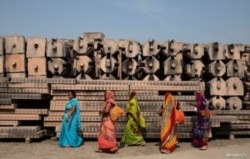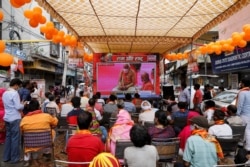In a ceremony watched by millions of Indians on television, Prime Minister Narendra Modi offered prayers and laid the foundation stone for a grand Hindu temple to be built in the northern town of Ayodhya on the site of a mosque demolished by Hindu radicals.
The ceremony marks a historic triumph for Modi’s Bharatiya Janata Party, whose rise to political prominence was propelled by the three-decade campaign to build a temple to honor the revered Hindu deity Rama.
“It is an emotional moment for India. A long wait ends today,” Modi said after the ceremony that was held even as the COVID-19 pandemic continues in India.
The temple is being built on the exact spot Hindus believe is the birthplace of Lord Rama. The demolition of the 16th century mosque that stood there in 1992 sparked deadly Hindu-Muslim riots and became a deeply divisive issue in the Hindu-majority country, where many Hindus want the temple to be built.
The Supreme Court approved the temple’s construction last November when it handed the bitterly contested plot of land to a Hindu group after a long legal battle.
Modi said the site had been liberated and a "grand house" would be constructed for Lord Rama.
Building the temple in Ayodhya has long been a rallying cry of the BJP, which critics accuse of pursuing a Hindu nationalist agenda. Wednesday’s groundbreaking ceremony coincided with the first anniversary of the scrapping of the special status for Muslim majority Kashmir — another core promise that was made by the party.
The response of the Muslim community to the temple project has been muted with some saying it is time to “move on.”
“Whatever happened are things of the past,” said Iqbal Ansari, one of the Muslim litigants in the Supreme Court case, who was invited to attend the ceremony.
The small, sleepy town of Ayodhya was given a makeover for the ceremony. Saffron flags fluttered in the streets and houses got a splash of yellow paint, both believed to be auspicious colors.
Paramilitary soldiers guarded the streets as COVID-19 restrictions kept people indoors. Many, however, stood on rooftops in the pilgrim town dotted with temples.
Wednesday’s ceremony marks the consolidation of Hindu nationalism under the BJP during its six-year rule, say analysts.
“A constellation of forces has allowed them to take advantage now, they have a favorable court judgment and all groups have come to believe that let us resolve the issue,” says Sandeep Shastri, a political analyst and Pro Vice Chancellor of Jain University. “This also seems to be the voice in the minority Muslim community that in order to buy peace if this is what we need to agree to, it is all right.”
The proposed five-domed temple spread over nearly 8,000 square meters, is expected to be completed in three-and-a-half years and could yield political dividends for the BJP when it faces the next general election in 2024.
“This reinforces Modi’s persona, the halo, he is the man who has delivered the temple,” says political analyst Nilanjan Mukhopadhyay. “This is the moment of Hindu supremacy, and Muslims recognize, and there is very little they can do by law after the Supreme Court rejected their petition for a review of its judgment.”
A prominent Muslim lawmaker questioned the prime minister’s attendance, though, at the ceremony, saying that it violated his constitutional oath in India. “Secularism is part of the Basic Structure of Constitution,” Asaduddin Owaisi wrote on Twitter.
There is unease among the Muslim community and some fear the construction of a temple at Ayodhya could pave the way for similar demands in other towns where Hindu groups claim mosques have been built on sites holy to Hindus.
“The larger question would be, would it end here or is this the starting point of other developments. That is the more serious question,” said Shastri.
Some questions also have been raised about holding the ceremony during a pandemic in India when there have been repeated warnings by health experts that large gatherings should be avoided.
The venue of the ceremony, attended by about 175 prominent BJP leaders and Hindu priests, was cordoned off and chairs kept at a distance to maintain social distancing.
The ceremony became a moment of celebration across many homes in the country, where the temple campaign turned into a deeply emotive issue. Hindus make up about 80 percent of the population.
Devotees are reported to have sent silver and gold coins to pay for the temple’s construction.











